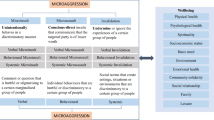Abstract
For decades, studies concerning microaggressions were primarily limited to those based in racism. While more recent research has expanded to microaggressions based in gender and sexuality, minimal research has been conducted on how microaggressions are experienced by people with disabilities. For the current study, ten adults with a congenital or acquired disabilities participated in semi-structured interviews where they shared their stories of microaggressions. Our qualitative analysis identified two sources (i.e., kids vs. adults; inside/outside the disabled community) and seven forms of microaggressions (i.e., denial of identity, denial of privacy, helpless treatment, spread effect, patronization, exoticization, and social distancing/isolation). Toxic positivity, a form of denying identity, and pitying, a form of helpless treatment, also emerged in our participants’ experiences.
Access this chapter
Tax calculation will be finalised at checkout
Purchases are for personal use only
Similar content being viewed by others
References
Ballard, R. L., Ballard, S. J., & Chue, L. E. (2023). Invisible marginalizations of service-dog handlers: The tensions of legal inclusion and social exclusion. In M. S. Jeffress, J. M. Cypher, J. Ferris, & J.-A. Scott (Eds.), The Palgrave handbook of disability and communication. Palgrave.
Baxter, L. A. (2011). Voicing relationships: A dialogic approach. Sage.
Braithwaite, D. O. (1991). “Just how much did that wheelchair cost?” Management of privacy boundaries by persons with disabilities. Western Journal of. Speech Communication, 55(3), 245–274. https://doi.org/10.1080/10570319109374384
Calder-Dawe, O., Witten, K., & Carroll, P. (2020). Being the body in question: Young people’s accounts of everyday ableism, visibility, and disability. Disability & Society, 35(1), 132–155. https://doi.org/10.1080/09687599.2019.1621742
Charmaz, K., & Rosenfeld, D. (2006). Reflections of the body, images of the self: Visibility and invisibility in chronic illness and disability. In P. Vannini & D. Waskul (Eds.), Body/embodiment: Symbolic interaction and the sociology of the body (pp. 35–49). Taylor & Francis.
Galvin, K. M. (2014). Blood, law, and discourse: Constructing and managing family identity. In L. A. Baxter (Ed.), Remaking ‘family’ communicatively (pp. 17–32). Peter Lang.
Garland-Thomson, R. (2002). The politics of staring: Visual representations of disabled people in popular culture. In S. L. Snyder, B. J. Brueggemann, & R. Garland-Thomson (Eds.), Disability studies: Enabling the humanities (pp. 56–75). Modern Language Association.
Kattari, S. K. (2019). The development and validation of the Ableist Microaggression Scale. Journal of Social Service Research, 45(3), 400–417. https://doi.org/10.1080/01488376.2018.1480565
Keller, R. M., & Galgay, C. E. (2010). Microaggressive experiences of people with disabilities. In D. W. Sue (Ed.), Microaggressions and marginality: Manifestation, dynamics, and impact (pp. 241–267). Wiley.
Lee, E.-J., Ditchman, N., Thomas, J., & Tsen, J. (2019). Microaggressions experienced by people with multiple sclerosis in the workplace: An exploratory study using Sue’s taxonomy. Rehabilitation Psychology, 64(2), 179–193. https://doi.org/10.1037/rep0000269
Lett, K., Tamaian, A., & Klest, B. (2020). Impact of ableist microaggressions on university students with self-identified disabilities. Disability & Society, 35(9), 1441–1456. https://doi.org/10.1080/09687599.2019.1680344
Lincoln, Y. S., & Guba, E. G. (1985). Naturalistic inquiry. Sage.
Olkin, R., H’Sien, H., Schaff Abbene, M., & VanHeel, G. (2019). The experiences of microaggressions against women with visible and invisible disabilities. Journal of Social Issues, 75(3), 757–785. https://doi.org/10.1111/josi.12342
Petronio, S. S. (2002). Boundaries of privacy: Dialectics of disclosure. State University of New York Press.
Piepzna-Samarasinha, L. L. (2018). Care work: Dreaming disability justice. Arsenal Pulp Press.
Roffee, J., & Wailing, A. (2016). Rethinking microaggressions and anti-social behavior against LGBTIQ+ youth. Safer Communities, 15(4), 190–201. https://doi.org/10.1108/SC-02-2016-0004
Saldaña, J. (2016). The coding manual for qualitative research (3rd ed.). Sage.
Siebers, T. (2008). Disability theory. University of Michigan Press.
Suárez-Orozco, C., Casanova, S., Martin, M., Katsiaficas, D., Cuellar, V., Smith, N. A., & Dias, S. I. (2015). Toxic rain in class: Classroom interpersonal microaggressions. Educational Researcher, 44(3), 151–160. https://doi.org/10.3102/0013189X15580314
Sue, D. W. (2010). Microaggressions and marginality: Manifestation, dynamics, and impact. Wiley and Sons.
Sue, D. W., Capodilupo, C. M., Torino, G. C., Bucceri, J. M., Holder, A. M. B., Nadal, K. L., & Esquilin, M. (2007). Racial microaggressions in everyday life: Implications for clinical practice. American Psychologist, 62(4), 271–286. https://doi.org/10.1037/0003-066X.62.4.271
Tigert, M. K., & Miller, J. H. (2021). Ableism in the classroom: Teaching accessibility and ethos by analyzing rubrics. Communication Teacher. https://doi.org/10.1080/17404622.2021.2006254
Yep, G. A., & Lescure, R. (2019). A thick intersectional approach to microaggressions. Southern Communication Journal, 84(2), 113–126. https://doi.org/10.1080/1041794X.2018.1511749
Author information
Authors and Affiliations
Corresponding author
Editor information
Editors and Affiliations
Rights and permissions
Copyright information
© 2023 The Author(s), under exclusive license to Springer Nature Switzerland AG
About this chapter
Cite this chapter
Sparrow, D., Parcell, E.S., Gerlikovski, E.R., Simpson, D.N. (2023). Microaggressions Toward People with Disabilities. In: Jeffress, M.S., Cypher, J.M., Ferris, J., Scott-Pollock, JA. (eds) The Palgrave Handbook of Disability and Communication. Palgrave Macmillan, Cham. https://doi.org/10.1007/978-3-031-14447-9_5
Download citation
DOI: https://doi.org/10.1007/978-3-031-14447-9_5
Published:
Publisher Name: Palgrave Macmillan, Cham
Print ISBN: 978-3-031-14446-2
Online ISBN: 978-3-031-14447-9
eBook Packages: Literature, Cultural and Media StudiesLiterature, Cultural and Media Studies (R0)




